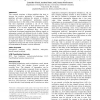Free Online Productivity Tools
i2Speak
i2Symbol
i2OCR
iTex2Img
iWeb2Print
iWeb2Shot
i2Type
iPdf2Split
iPdf2Merge
i2Bopomofo
i2Arabic
i2Style
i2Image
i2PDF
iLatex2Rtf
Sci2ools
CHI
2007
ACM
2007
ACM
Matching attentional draw with utility in interruption
This research examines a design guideline that aims to increase the positive perception of interruptions. The guideline advocates matching the amount of attention attracted by an interruption's notification method (attentional draw) to the utility of the interruption content. Our first experiment examined a set of 10 visual notification signals in terms of their detection times and established a set of three significantly different signals along the spectrum of attentional draw. Our second experiment investigated matching these different signals to interruption content with different levels of utility. Results indicate that the matching strategy decreases annoyance and increases perception of benefit compared to a strategy that uses the same signal regardless of interruption utility, with no significant impact on workload or performance. Design implications arising from the second experiment as well as recommendations for future work are discussed. Author Keywords Interruption, a...
Author Keywords Interruption | CHI 2007 | Human Computer Interaction | Interruption Content | Interruption Utility |
| Added | 30 Nov 2009 |
| Updated | 30 Nov 2009 |
| Type | Conference |
| Year | 2007 |
| Where | CHI |
| Authors | Jennifer Gluck, Andrea Bunt, Joanna McGrenere |
Comments (0)

